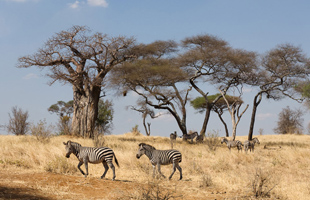Tarangire National Park
Tarangire National Park covers 2600 sq km of grassland and floodplains, and a large proportion of tall acacia woodland just south of the large open grass plains of southern Maasailand. It is beautifully unspoilt, and drives through the park enjoy wide views to distant variously purpled formations of volcanic mountain ranges.
Tarangire also has regions of quite dense bush, but with high grasses and huge old baobab trees instead of the green forests of Manyara. The land is hilly and dominated by the impressive valley of the Tarangire River, which attracts good numbers of migrant animals during the dry months, especially between July and September.
During these months the concentration of animals around the Tarangire river is almost as diverse and reliable as in the Ngorongoro crater, but again ecosystem here is balanced by a localised migration pattern that is followed by most the animals other than lion, who don’t tend to abandon their territory.
The animals mostly disperse during April and May, when there is widespread greenery, vegetation and standing water to encourage all the grazers further afield. In June, the eland and oryxes begin to return, followed by elephant towards the end of the month. Tarangire is a great spot for elephant gatherings at the end of the rainy season in June, and zebra and wildebeest return together through July.
By mid-August, all the animals are congregating around their last reliable water source, the Tarangire River. The calving season falls in the early months of the year, through January, February and March, and so makes the most of the fresh grass during the rainy season.
Throughout the year there are always a fantastic number of colourful birds swooping and strutting along the rough paths in front of your vehicle, with likely spots including the Paradise Whyder and endearing Yellow-collared lovebirds. There are a few resident lion, which are easier to find when the migration arrives to excite their taste buds. In other months they look quite mean and lean and slip easily between the grasses.
The park is especially known for its elephants, which re more numerous than in the other northern parks. On a good day, you might even spot 300 elephants at a time! Apart from This, there are good chances of spotting buffaloes, giraffes, water bucks, kudus, oryxes, lions, lions, leopards, hyenas, and if you are lucky, you.>> Book Now





